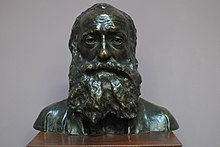Ghevont Alishan
Ghevont Alishan | |
|---|---|
 Portrait of Alishan from his 1901 book Hayapatum (Հայապատում, "Armenian History") | |
| Church | Catholic Church |
| Personal details | |
| Born | July 6, 1820 Constantinople, Ottoman Empire |
| Died | November 9, 1901 (aged 81) Venice, Kingdom of Italy |
| Nationality | Armenian |
| Denomination | Armenian Catholic |
| Residence | San Lazzaro degli Armeni |

Ghevont Alishan (Armenian: Հայր Ղևոնդ Ալիշան) (1820-1901; also spelled Ghevond Alishan) was an ordained Armenian Catholic priest, historian and a poet. He was awarded by the Legion of Honour of the French Academy (1866), an honorary member of the Asian Society of Italia, Archeological Society of Moscow, Venice Academy and Archeological Society of Saint-Petersburg.
John Ruskin wrote that he "always looked upon him Padre Alishan as a sort of saint; he has been our friend for a great many of years."[1]
He was a member of the Mkhitarist Congregation in Venice beginning in 1838. In 1885 he created the first modern Armenian flag. His first design was a horizontal tricolor, but with a set of colors different from those used on the Armenian flag of today. The top band would be red to symbolize the first Sunday of Easter (called "Red" Sunday), the green to represent the "Green" Sunday of Easter, and finally an arbitrary color, white, was chosen to complete the combination. While in France, Alishan also designed a second flag inspired by the national Flag of France. Its colors were red, green, and blue respectively, representing the band of colors that Noah saw after landing on Mount Ararat.

A bust of Alishan, created in 1903 by the sculptor , is displayed in the National Gallery of Armenia.[2]
Publications[]
- «Յուշիկք հայրենեաց հայոց» (Memories of the Armenian Homeland) 1869.
- «Շիրակ» (Shirak) 1881.
- «Սիսուան» (Sisouan) 1885.
- «Այրարատ» (Ayrarat) 1890.
- «Սիսական» (Sisakan) 1893.
- «Հայապատում» ('Hayapatum', Armenian History). 1901, Venice.
- «Շնորհալի եւ պարագայ իւր» ('Shnorhali ew paragay iwr', Armenian History). 1873, Venice.
See also[]
References[]
External links[]
- Works by or about Ghevont Alishan at Internet Archive
- Armenia at Flags of the World
- The Evolution of the Armenian Flag
- Armenians of the Ottoman Empire
- 1820 births
- 1901 deaths
- Writers from Istanbul
- Ethnic Armenian historians
- Mekhitarists
- Armenian Eastern Catholic priests
- Ethnic Armenian poets
- Catholic poets
- Ottoman emigrants to Austria-Hungary
- Armenian male poets
- Armenian studies scholars
- Armenian educators
- Armenian lexicographers
- 19th-century Armenian poets
- 19th-century Armenian historians
- Armenian geographers
- 19th-century male writers
- Eastern Catholic poets
- Mount Ararat
- 19th-century lexicographers
- Armenian religious biography stubs
- Armenian writer stubs
- Asian historian stubs
- European historian stubs
- Armenian history stubs